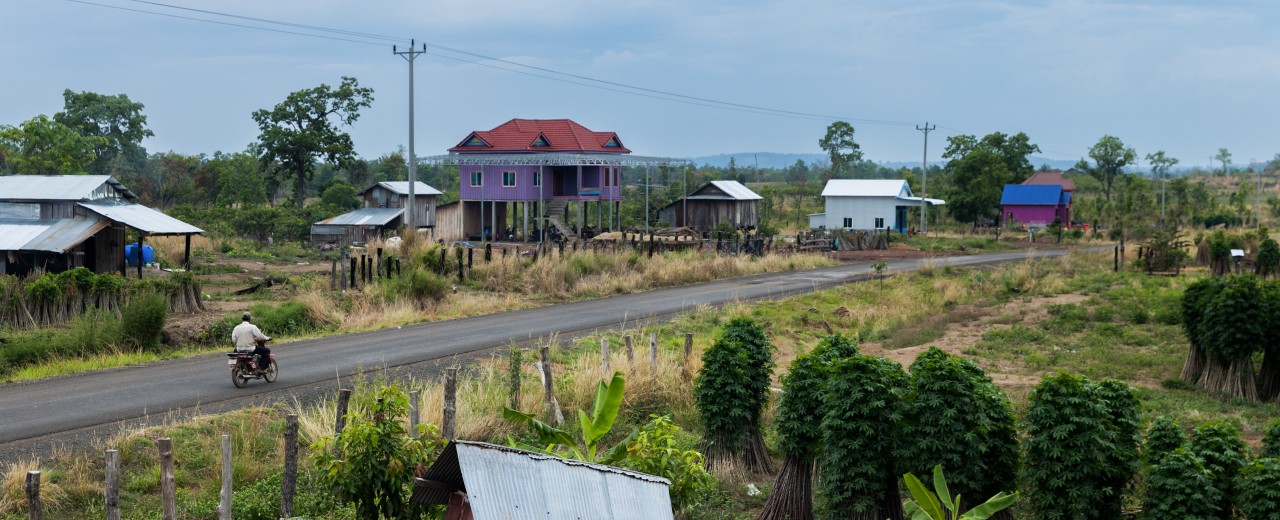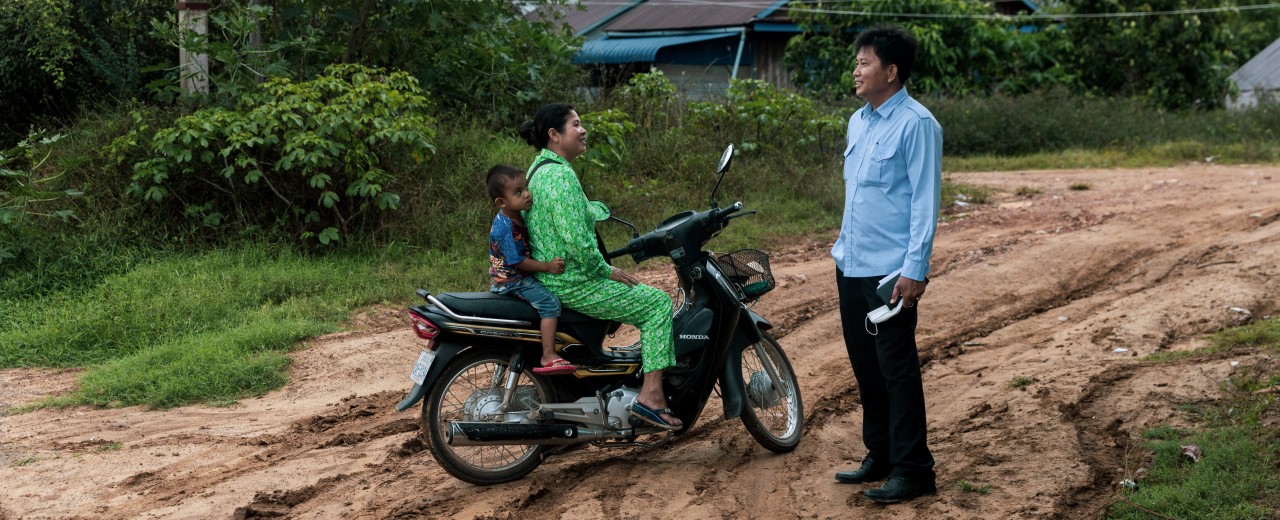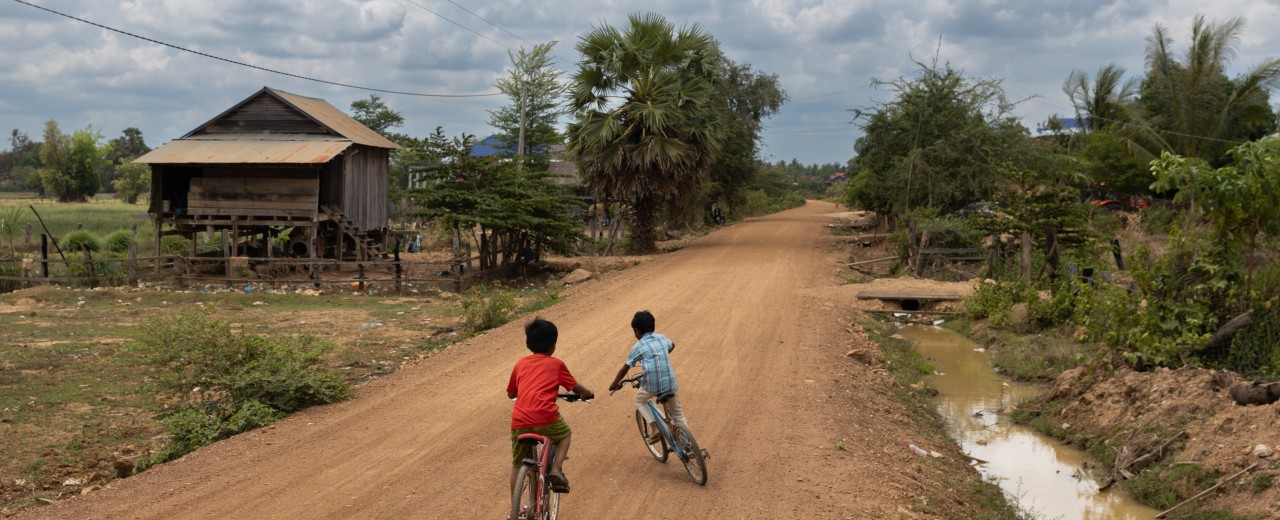
From April to October, Cambodia has a rainy season with long and heavy rainfalls caused by the humid southwest monsoon. 70 to 80% of the annual rainfall falls during this period, rainfall amounts of up to 5000 mm are not uncommon. Due to the poor infrastructure in rural areas, a heavy shower can make roads impassable for several days and destroy drainage ditches and bridges. Villages are cut off from the outside world, and people can no longer reach schools, markets and hospitals.
Climate change, with a prolonged dry season and a monsoon season with ever-increasing rainfall, exacerbates this situation, with typhoons, floods, landslides and droughts occurring again and again. But also the rising traffic - with growing prosperity - is causing problems on the roads, especially overloaded trucks.
In rural Cambodia, the poor road network was - and still is - a decisive obstacle to development. For many years, KfW Development Bank has therefore been promoting rural infrastructure programmes on behalf of the BMZ: with the expansion of rural roads, bridges and supplementary small-scale infrastructure in 15 provinces. Together with the Cambodian Ministry of Rural Development (MRD), roads, bridges, regional marketplaces and other small-scale infrastructure have been built. Even during extreme flooding, roads are usable during the rainy season thanks to newly built dams, drainage, and erosion control. Thousands of Cambodians thus gained faster and year-round access to trading places and social and medical facilities. Thanks to the improved infrastructure, rural households are now better able to sell their agricultural produce, shop for others, take up jobs, take advantage of educational opportunities and participate in public life. Household incomes in the catchment areas of roads and markets increased significantly.

Local construction companies were hired to pave roads, construct drainage ditches and build culverts. Small-scale infrastructure works were also implemented in the villages and communities bordering the roads. Village communities were involved in the selection of complementary infrastructure, often opting for the construction of smaller access roads, community rooms or even rice drying slabs. Road safety programmes for drivers and pedestrians were also established - as driving speeds increase with better roads. In addition, the local executing agency's staff were trained in maintenance management.
In 2020, the new Rural Infrastructure Development Programme for Cambodia (RID4CAM) was pledged, which builds on the previous phases and has been shaped into a comprehensive and integrated overall programme through various funding contributions. RID4CAM is being implemented in co-financing with the Agence Française de Développement (AFD) and, in addition to the AFD loan, includes two further phases of the rural infrastructure programme, a KfW low-interest loan (Phase VIII) and a BMZ grant (Phase VII). Furthermore, KfW receives an EU AIF grant for the implementation of RID4CAM. Project implementation has started in 2021.
This project also combines the climate-resilient rehabilitation of rural roads and streets for year-round access to labour and sales markets as well as education and health facilities with the elimination of deficits in various complementary areas such as agricultural productivity and water supply infrastructure. Complementary training measures for capacity development of the project executing agency, the local project implementation units and the beneficiary target group, especially on maintenance and operation of the infrastructure, are to contribute to the sustainability of the project. RID4CAM follows a network approach, i.e. the creation of a high level of connectivity that enables the harmonised development of a larger region. This means that RID4CAM not only builds main roads, but also smaller connecting roads that feed into the main roads, thus facilitating the connection of farms to markets and promoting the development of local businesses. RID4CAM has also been closely integrated with the AFD-funded irrigation project "Water Resources Management and Agro-Ecological Transition for Cambodia" (WAT4CAM). The interaction of WAT4CAM and RID4CAM pursues an integrated approach to the development of economic infrastructure in rural areas, in which the positive effects of improved irrigation infrastructure and roads and paths that are passable all year round complement and reinforce each other. The roads financed under RID4CAM in the vicinity of WAT4CAM irrigation systems provide rural producers with year-round access to means of production and sales markets in a timely and cost-effective manner.

A few figures on the impacts of a predecessor programme that was implemented from 2014 to 2018: 15 road sections with a total length of 86.5 km were rehabilitated, 14 classrooms and sanitary facilities were added to four schools and water supply measures (especially wells) were implemented in 15 villages. The programme objective formulated at appraisal – the poor rural population, especially women, increase their income and actively participate in local sustainable economic development – was achieved. The volume of traffic – motor vehicles, motorbikes and pedestrians – on the rehabilitated roads has multiplied, all year round, not just in the dry season. More than 3,000 households in the villages benefit directly.
Share page
To share the content of this page with your network, click on one of the icons below.
Note on data protection: When you share content, your personal data is transferred to the selected network.
Data protection
Alternatively, you can also copy the short link: https://www.kfw-entwicklungsbank.de/s/enzBY0RA
Copy link Link copied